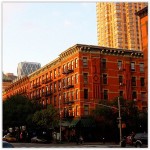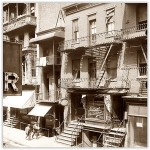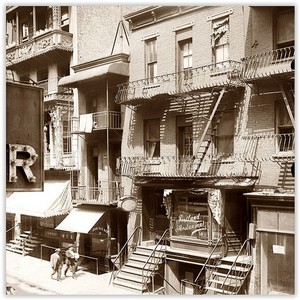 Hell’s Kitchen, also known as Clinton and Midtown West, is a neighborhood of Manhattan in New York City located between 34th Street in the south, 59th Street in the north, Eighth Avenue in the east, and the Hudson River to the west. The area provides transport, medical, and warehouse infrastructure support to the Midtown Manhattanbusiness district.
Hell’s Kitchen, also known as Clinton and Midtown West, is a neighborhood of Manhattan in New York City located between 34th Street in the south, 59th Street in the north, Eighth Avenue in the east, and the Hudson River to the west. The area provides transport, medical, and warehouse infrastructure support to the Midtown Manhattanbusiness district.
Once a bastion of poor and working-class Irish Americans, Hell’s Kitchen’s proximity to Midtown has changed it over the last three decades of the 20th century and into the new millennium. The 1969 edition of the City Planning Commission’s Plan for New York City reported that development pressures related to its Midtown location were driving people of modest means from the area, and the gritty reputation that Hell’s Kitchen developed afterward kept real estate prices below those of most other areas of Manhattan until the early 1990s. Today, the area is gentrifying,and average rents in the neighborhood have increased dramatically so that as of April 2014, rents in the area are above the average rents in Manhattan.
The rough-and-tumble days on the West Side figure prominently in Damon Runyon’s stories and is the childhood home of Marvel Comics’ Daredevil and Nick Fury. Being near to both Broadway theatres and Actors Studio training school, the area has long been a home to actors learning and practicing their craft.
HISTORY
Early history and development
On the island of Manhattan as it was wheEarly history and developmentn Europeans first saw it, the Great Kill formed from three small streams that united near present-day Tenth Avenue and 40th Street, then wound through the low-lying Reed Valley, renowned for fish and waterfowl, to empty into theHudson River at a deep bay on the river at the present 42nd Street. The name was retained in a tiny hamlet, Great Kill, that became a center for carriage-making, while the upland to the south and east became known as Longacre, the predecessor of Longacre, now Times Square. One of the large farms of the colonial era in this neighborhood was that of Andreas Hopper and his descendants, extending from today’s 48th Street nearly to 59th Street and from the river east to what is now Sixth Avenue. One of the Hopper farmhouses, built in 1752 for John Hopper the younger, stood near 53rd Street and Eleventh Avenue; christened “Rosevale” for its extensive gardens, it was the home of the War of 1812 veteran, Gen. Garrit Hopper Striker, and lasted until 1896, when it was demolished. The site was purchased for the city and naturalistically landscaped by Samuel Parsons Jr. as DeWitt Clinton Park. In 1911 New York Hospital bought a full city block largely of the Hopper property, between 54th and 55th Streets, Eleventh and Twelfth Avenues. Beyond the railroad track, projecting into the river at 54th Street, was Mott’s Point, with an 18th-century Mott family house surrounded by gardens that was inhabited by members of the family until 1884 and survived until 1895.
A lone surviving structure that dates from the time this area was open farmland and suburban villas is the carriage house (pre-1800) that once belonged to a villa owned by ex-Vice President and New York State governor George Clinton, now in a narrow court behind 422 West 46th Street. From 1811 until it was officially de-mapped the ghostly Bloomingdale Square was part of the city’s intended future; it extended from 53rd to 57th Streets between Eighth and Ninth Avenues. It was eliminated in 1857 after the establishment of Central Park,and the name shifted to the junction of Broadway, West End Avenue, and 106th Street, now Straus Park. In 1825, the City purchased for $10 clear title to a right-of-way through John Leake Norton’s farm, “The Hermitage”, to lay out 42nd Street clear to the river. Before long, cattle ferried from Weehawken were being driven along the unpaved route to slaughterhouses on the East Side. Seventy acres of the Leake (later Norton) property, extending north from 42nd to 46th Street and from Broadway to the river, had been purchased before 1807 by John Jacob Astor and William Cutting, who held it before dividing it into building lots as the district became more suburban.
Unity with the city and deterioration
The first change that began to unite the area more closely to New York City was the construction of the Hudson River Railroad, which completed the forty miles to Peekskill on September 29, 1849, to Poughkeepsie by the end of that year, and extended to Albany in 1851. As far as 60th Street, the track ran at street grade up Eleventh Avenue, before the independent riverside roadbed commenced.[19]
The formerly rural riverfront was transformed for industrial uses such as tanneries that could discharge their effluent into the river and ship their production by the rails. Hence the beginnings of the neighborhood of the southern part of the 22nd Ward, which would become known as Hell’s Kitchen, start in the mid-19th century, when immigrants from Ireland, most of them refugees from the Great Famine, began settling on the west side of Manhattan in shantytowns along the Hudson River. Many of these immigrants found work on the docks nearby, or along the railroad that carried freight into the city along Eleventh Avenue.
 After the American Civil War the population increased dramatically, as tenements were erected and increased immigration added to the neighborhood’s congestion. Many in this poverty stricken area turned to gang life and the neighborhood soon became known as the “most dangerous area on the American Continent”. Around the start of the 20th century, the neighborhood was controlled by gangs, including the violent Gopher Gang led by One Lung Curran and later by Owney Madden. The violence escalated during the 1920s, after Prohibitionwas implemented in 1919. The many warehouses in the district served as ideal breweries for the rumrunners who controlled the illicit liquor. Gradually the earlier gangs such as the Hell’s Kitchen Gang were transformed into organized crime entities around the same time thatOwney Madden became one of the most powerful mobsters in New York.
After the American Civil War the population increased dramatically, as tenements were erected and increased immigration added to the neighborhood’s congestion. Many in this poverty stricken area turned to gang life and the neighborhood soon became known as the “most dangerous area on the American Continent”. Around the start of the 20th century, the neighborhood was controlled by gangs, including the violent Gopher Gang led by One Lung Curran and later by Owney Madden. The violence escalated during the 1920s, after Prohibitionwas implemented in 1919. The many warehouses in the district served as ideal breweries for the rumrunners who controlled the illicit liquor. Gradually the earlier gangs such as the Hell’s Kitchen Gang were transformed into organized crime entities around the same time thatOwney Madden became one of the most powerful mobsters in New York.
After the Repeal of Prohibition, many of the organized crime elements moved into other rackets, such as illegal gambling and union shakedowns. The postwar era was characterized by a flourishing waterfront, and longshoreman work was plentiful. By the end of the 1950s, however, the implementation of containerized shipping led to the decline of the West Side piers and many longshoremen found themselves out of work. In addition, the construction of the Lincoln Tunnel had devastated much of Hell’s Kitchen to the south of 39th Street.
In 1959, an aborted rumble between rival Irish and Puerto Rican gangs led to the notorious “Capeman” murders in which two innocent teenagers were killed. By 1965, Hell’s Kitchen was the home base of the Westies, a deeply violent Irish American crew aligned with theGambino crime family. It was not until the early 1980s that widespread gentrification began to alter the demographics of the longtime working-class Irish American neighborhood. The 1980s also saw an end to the Westies’ reign of terror, when the gang lost all of its power after the RICO convictions of most of its principals in 1986.

